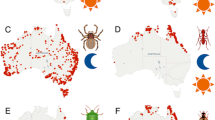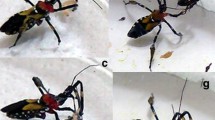Abstract
The tropical forest rove beetle Leistotrophus versicoloris a specialized obligate predator of adult Diptera that exhibits unusual flexibility and complexity in the capture of its prey. Individuals can be located on vertebrate dung or carrion, where they wait to ambush incoming flies drawn to these materials. But in places without rotting materials, the beetles switch to waiting on leaves or rocks, where they may use secretions to lure very small flies to them. Evidence for chemical luring comes from observations of small flies closely approaching and sometimes touching immobile beetles. In addition, the beetles have several specialized behavior patterns that involve the release of highly scented secretory or excretory products from structures at the tip of the abdomen. These materials may be deposited on the substrate, with the beetle then positioning its head over the applied substances, or the beetle may wave its abdomen tip with its scent-releasing devices toward small flies that happen to approach it. The ability to employ alternative tactics enables individuals to forage successfully even in areas that do not contain fly-attracting rotting matter.
Similar content being viewed by others
References
Alcock, J., and Forsyth, A. (1988). Post-copulatory aggression toward their mates by males of the rove beetleLeistotrophus versicolor (Coleoptera: Staphylinidae).Behav. Ecol. Sociobiol. 22: 303–308.
Araujo, J. (1978). Anatomie comparée des systèmes glandulaires de défense chimique des Staphylinidae.Arch. Biol. 89: 217–250.
Balduf, W. V. (1935). The bionomics of the entomophagous Coleoptera. Classey, Hampton, Middlesex (1969 reprint).
Bristowe, W. S. (1958).The World of Spiders, Collins, London.
Curio, E. (1976).The Ethology of Predation, Springer-Verlag, Berlin.
Dawkins, R. (1980). Good strategy or evolutionarily stable strategy? In Barlow, G. W., and Silverberg, J. (eds.),Sociobiology: Beyond Nature/Nurture? Westview Press, Boulder, Colo., pp. 331–367.
Dettner, K. (1987). Chemosystematics and the evolution of beetle chemical defenses.Annu. Rev. Entomol. 32: 17–48.
Eberhard, W. G. (1977). Aggressive chemical mimicry by a bolas spider.Science 198: 1173–1175.
Fish, L. J., and Pattenden, G. (1975). Iridodial, and a new alkanone, 4-methylhexan-3-one, in the defensive secretion of the beetle,Staphylinus olens.J. Insect Physiol. 21: 741–744.
Forsyth, A., and Alcock, J. (1990). Female mimicry and resource defense polygyny by males of a tropical rove beetleLeistotrophus versicolor (Coleoptera: Staphylinidae).Behav. Ecol. Sociobiol. 26: 325–330.
Forsyth, A., and Peck, S. J. (1982). Competition, structure and competitive behaviour in a guild of Ecuadorian rainforest dung beetles (Coleoptera: Scarabeidae).Can. J. Zool. 60: 1624–1634.
Heinrich, B., and Bartholomew, G. A. (1979). Ecology of the African dung beetle.Sci. Am. 241(5): 146–156.
Janzen, D. (1983). Seasonal change in abundance of large nocturnal dung beetles (Scarabeidae) in a Costa Rican deciduous forest and adjacent horse pasture.Oikos 41: 274–283.
Lloyd, J. E. (1965). Aggressive mimicry inPhoturis: firefly femmes fatales.Science 149: 653–654.
Lloyd, J. E. (1984). On deception, a way of all flesh, and firefly signalling and systematics. In Dawkins, R., and Ridley, M. (ed.),Oxford Surveys of Evolutionary Biology, Oxford University Press, Oxford, pp. 48–84.
Lloyd, J. E., and Wing, S. R. (1983). Nocturnal aerial predation of fireflies by light-seeking fireflies.Science 222: 634–635.
Morse, D. H. (1980).Behavioral Mechanisms in Ecology, Harvard University Press, Cambridge, Mass.
Peschke, K. (1987). Male aggression, female mimicry and female choice in the rove beetle,Aleochara curtula.Ethology 75: 265–284.
Schaller, G. B. (1972).The Serengeti Lion, University of Chicago Press, Chicago.
Schoener, T. W. (1967). The ecological significance of sexual dimorphism in size in the lizardAnolis conspersus.Science 155: 474–477.
Schoener, T. W. (1974). Resource partitioning in ecological communities.Science 185: 27–39.
Stowe, M. K. (1988). Chemical mimicry. In Spencer, K. (ed.),The Chemical Mediation of Coevolution, Academic Press, New York, pp. 513–580.
Thornhill, R., and Alcock, J. (1983).The Evolution of Insect Mating Systems, Harvard University Press, Cambridge, Mass.
Author information
Authors and Affiliations
Rights and permissions
About this article
Cite this article
Forsyth, A., Alcock, J. Ambushing and prey-luring as alternative foraging tactics of the fly-catching rove beetleLeistotrophus versicolor (Coleoptera: Staphylinidae). J Insect Behav 3, 703–718 (1990). https://doi.org/10.1007/BF01065960
Accepted:
Issue Date:
DOI: https://doi.org/10.1007/BF01065960




